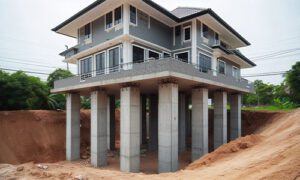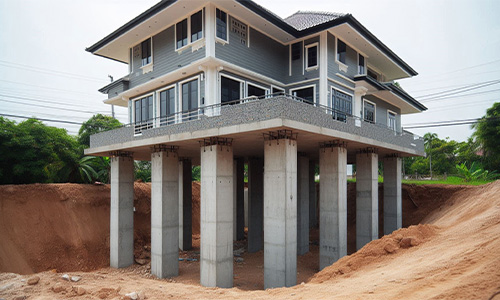
Flooding is one of the worst natural disasters a homeowner can face. Flooding can ruin the foundation of your home, destroy the interiors, and become an expensive couple of repairs for thousands of dollars. Luckily, there is a reliable engineering solution to remain above water. Building lifting engineering is a new technique that elevates your entire home above a flood zone, protecting against future water damage.
In this blog, we will take a look at how building lifting works, when to employ building lifting, and why it could be the best step for homeowners who are in flood-prone areas.
Table of Contents
- What Is Building Lifting Engineering
- Why You Should Consider Lifting Your Home
- How Building Lifting Protects Against Flooding
- Signs You Might Need Building Lifting
- The Building Lifting Process Explained
- Is Building Lifting Safe and Reliable
- Cost and Time Involved
- Benefits Beyond Flood Protection
- Why Hire Professionals for the Job
- Conclusion
- FAQs
What Is Building Lifting Engineering?
Building lifting is a structural engineering technique that involves raising an entire building or house above its current foundation. Hydraulic jacks and steel supports are used to carefully lift the structure while a new, elevated foundation is built beneath it.
This technique is commonly used in flood-prone areas to elevate homes above the base flood elevation level, ensuring water flows below the structure rather than into it.
Why You Should Consider Lifting Your Home?
Building lifting is more than just addressing flooding – it is significantly more about protecting safety, comfort, and value in the long term. Here are several strong reasons why homeowners should consider lifting their property:
✅ Insistence of Frequent Flooding Issues
If you are continuing to experience episodic seasonal flooding, lifting / elevation is the best option of circumventing flood water overlapping your property like a bathtub.
✅ Existing Damage to Foundation or Sinking
With time, settlement of the foundation can be attributed to several causes in either hard or soft soils, like soil erosion, waterlogged conditions, or in some cases prolonged water infiltration. Properly elevating your home can reclaim the critical foundation work.
✅ Growing Need for a Basement Addition or Additional Parking
When you lift your home, you create vertical space under the house which can be used for storage, parking, or another basement.
✅ To Prevent Long-term Water Damage
Moisture can cause mold, wood rot, and health hazards if they free-fall within the envelope of your home. Elevation allows for preventative measures towards moisture issues.
✅ Improved Drainage around the Property
Elevation details enable more reliable water runoff patterns thus eliminating pooling waters around the structure.
✅ Airflow Circulation Under and Within the Structure
A lifted home will seamlessly improve conditions for better underfloor air circulation and reduce humidity and parasitic interactions with the ground foundation.
✅ Increased Property Valuation
Homes that are built above flood risk areas that have substantive structural liability. Thus, selling a home that is lifted and in a flood risk area would build secure pricing structures or improve the saleability and sustainability of your real estate investment.
✅ Future-Proofing Against Climate Change
With rising sea levels and unpredictable weather patterns, lifting your home today prepares you for tomorrow’s challenges.
How Building Lifting Protects Against Flooding?
When a home is raised above the flood level:
- Floodwater cannot enter your living space.
- Structural damage due to water pressure is avoided.
- Mold, mildew, and waterborne diseases are prevented.
House lifting services create a physical barrier between your home and the water, giving you peace of mind during monsoon or storm seasons.
Signs You Might Need Building Lifting
Not sure if building lifting is the right solution for your home? Look out for these warning signs that indicate structural or flood-related risks that lifting can effectively address:
- Cracks in Walls or Foundation
Visible horizontal or stair-step cracks are signs of shifting or settling foundations. - Frequent Water Logging Around the Property
If water accumulates near the foundation or doesn’t drain properly, it can weaken the base over time. - Visible Tilting or Sinking of the Structure
An uneven or sunken foundation can compromise the stability of your entire home. - Past Incidents of Flood Damage
Previous flooding events increase the risk of future damage and mold growth. - Uneven Floors or Sloping Rooms
If floors feel slanted or unbalanced, it could mean the foundation is settling unevenly. - Low Elevation Compared to Neighboring Properties
If nearby homes are visibly higher, yours may be at greater flood risk and require lifting.
- Cracks in Walls or Foundation
The Building Lifting Process Explained
- Inspection & Planning: Engineers assess the site and prepare a lifting strategy.
- Foundation Preparation: The area around the base is cleared.
- Installation of Jacks & Beams: Hydraulic jacks are placed under the house for even lifting.
- Lifting Phase: The building is lifted slowly and safely.
- New Foundation Construction: A higher foundation is built to the required height.
- Lowering & Final Touches: The house is set on the new foundation, utilities reconnected, and the site cleaned.
Is Building Lifting Safe and Reliable?
Yes, when handled by experienced professionals. Modern equipment, structural analysis, and skilled labor make this method extremely safe. Building lifting service providers ensure that structural integrity is maintained throughout the process.
Cost and Time Involved
- Cost: Depends on home size, weight, height of lift, and foundation work.
- Time: Typically 4–8 weeks, depending on the complexity.
While it’s a significant investment, the long-term savings on flood damage, insurance, and peace of mind are worth it.
Benefits Beyond Flood Protection
- Increased property value
- Extra living or storage space
- Better drainage and airflow
- Stronger, more durable foundation
- Enhanced safety and security
Why Hire Professionals for the Job
Building lifting is not a DIY job. It requires:
- Structural engineers
- Trained contractors
- Specialized equipment
- Local permits and compliance
Choosing an experienced lifting and shifting engineering company ensures safety, accuracy, and long-term results.
Conclusion
Flooding is unpredictable but your home’s safety doesn’t have to be. Building lifting engineering is a smart, future-proof investment for homeowners in flood-prone zones. It not only prevents water damage but also enhances your home’s structure and functionality. Don’t wait for the next storm to take action, partner with an experienced construction company to lift your home, and your peace of mind.
Ready to Protect Your Home from Floods?
Frequently Asked Questions
Homes can typically be lifted anywhere from a few inches to over 12 feet, depending on the flood zone requirements and local regulations.
No, residents are required to vacate the premises during the lifting and foundation construction for safety.
Temporary disconnection and later reconnection of utilities are part of the process. Professionals handle this with care.

